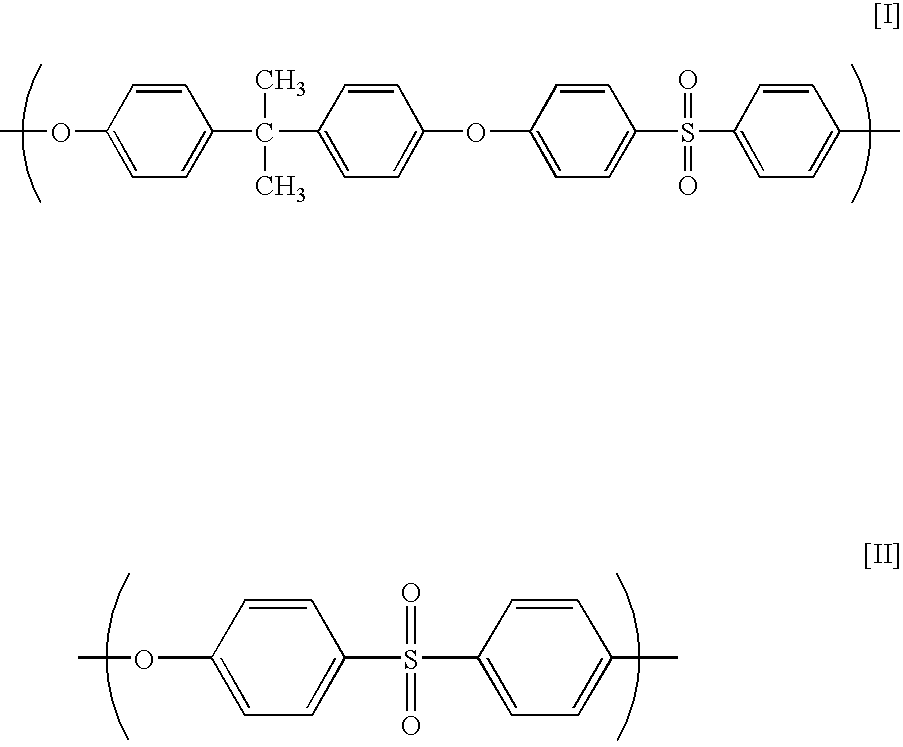Polysulfone-based hollow-fiber membrane with selective permeability
a polysulfone-based, hollow fiber membrane technology, applied in the direction of membranes, filtration separation, separation processes, etc., can solve the problems of poor affinity of semipermeable membranes made up of polysulfone resin alone, inability to directly treat blood, and accumulation of eluted hydrophilic polymers, etc., to achieve reliable safety and performance stability, and easy integration into modules
- Summary
- Abstract
- Description
- Claims
- Application Information
AI Technical Summary
Benefits of technology
Problems solved by technology
Method used
Image
Examples
example 1
[0115] Polyethersulfone (SUMIKAEXCEL®4800P, manufactured by Sumika Chem Tex Co., Ltd.) (17.6 mass %), polyvinyl pyrrolidone (COLIDONE®K-90 manufactured by BASF) (4.8 mass %), dimethylacetamide (DMAc) (74.6 mass %) and RO water (3 mass %) were homogeneously dissolved at 50° C., and then, the system was vacuumed up to −500 mmHg with a vacuum pump. After that, the system was immediately sealed so as not to change the composition of the membrane-forming solution due to the evaporation of the solvent or the like, and the system in this state was left to stand alone for 15 minutes. This operation was repeated three times so as to degas the membrane-forming solution. This solution was allowed to pass through sintered filters with pore sizes of 30 μm and 15 μm in two stages, and then was extruded from the outer slit of a tube-in-orifice nozzle heated to 65° C. Simultaneously with this extrusion, an aqueous solution of DMAc (45 mass %) of 15° C. as an interior-coagulating solution which had ...
example 2
[0123] Polyethersulfone (SUMIKAEXCEL®4800P, manufactured by Sumika Chem Tex Co., Ltd.) (18.8 mass %), polyvinyl pyrrolidone (COLIDONE®K-90 manufactured by BASF) (5.2 mass %), DMAc (71.0 mass %) and water (5 mass %) were dissolved at 50° C., and then, the system was vacuumed up to −700 mmHg with a vacuum pump. After that, the system was immediately sealed so as not to change the composition of the membrane-forming solution due to the evaporation of the solvent or the like, and the system in this state was left to stand alone for 10 minutes. This operation was repeated three times so as to degas the membrane-forming solution. This solution was allowed to pass through filters with pore sizes of 15 μm and 15 μm in two stages, and then was extruded from the outer slit of a tube-in-orifice nozzle heated to 70° C. Simultaneously with this extrusion, an aqueous solution of DMAc (55 mass %) of 10° C. as an interior-coagulating solution which had been previously degassed for 2 hours under a p...
example 3
[0131] Polysulfone (P-3500 manufactured by AMOCO) (18.5 mass %), polyvinyl pyrrolidone (K-60 manufactured by BASF) (9 mass %), DMAc (67.5 mass %) and water (5 mass %) were dissolved at 50° C. Then, the inner space of the system was vacuumed up to −300 mmHg with a vacuum pump, and then was immediately sealed so as not to change the composition of the membrane-forming solution due to the evaporation of the solvent or the like and left to stand alone for 15 minutes. This operation was repeated three times to degas the membrane-forming solution. The resultant membrane-forming solution was allowed to pass through filters with pore sizes of 15 μm and 15 μm in two stages, and then was extruded through the outer slit of a tube-in-orifice nozzle heated to 40° C. Simultaneously with this extrusion, an aqueous solution of 35 mass % of DMAc of 0° C. as a void-forming agent which had been previously degassed under reduced pressure was extruded through the inner hole of the tube-in-orifice nozzle...
PUM
| Property | Measurement | Unit |
|---|---|---|
| depth | aaaaa | aaaaa |
| depth | aaaaa | aaaaa |
| depth | aaaaa | aaaaa |
Abstract
Description
Claims
Application Information
 Login to View More
Login to View More - R&D
- Intellectual Property
- Life Sciences
- Materials
- Tech Scout
- Unparalleled Data Quality
- Higher Quality Content
- 60% Fewer Hallucinations
Browse by: Latest US Patents, China's latest patents, Technical Efficacy Thesaurus, Application Domain, Technology Topic, Popular Technical Reports.
© 2025 PatSnap. All rights reserved.Legal|Privacy policy|Modern Slavery Act Transparency Statement|Sitemap|About US| Contact US: help@patsnap.com

